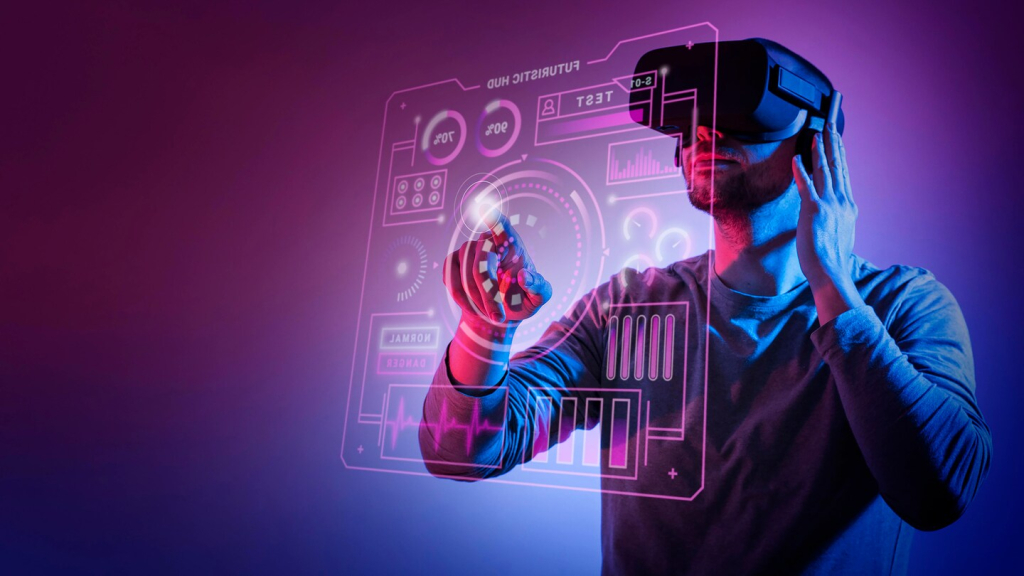Introduction to The Rapidly Evolving Digital Landscape

The year 2023 witnessed a remarkable surge in technological advancements that reshaped various industries and how people interact with the digital world. From artificial intelligence and machine learning to augmented reality and virtual reality, the tech landscape has experienced significant transformations in the way we exchange data and transmit data. Additionally, other emerging technologies and technological innovation like quantum computing and edge computing gained momentum, promising a future of limitless possibilities. This article will explore the top tech trends that defined 2023 and their impact on various industries.
Artificial Intelligence and Machine Learning in Various Industries
Impact on Healthcare Industry
Artificial intelligence (AI) and machine learning (ML) revolutionized multiple sectors in 2023. With the ability to process vast amounts of data and extract valuable insights, AI and ML played a crucial role in enhancing decision-making processes and optimizing operations. In healthcare, AI algorithms were employed to analyze medical records and patient outcomes, enabling early detection of diseases and personalized treatment plans. Moreover, AI-powered chatbots revolutionized customer service by providing 24/7 support and resolving queries efficiently.
Applications in Finance and Transportation and Logistics
In the financial industry, AI algorithms were leveraged for fraud detection, risk assessment, and algorithmic trading. These technologies enabled financial institutions to identify potential fraudulent activities in real time and make data-driven investment decisions. Furthermore, AI and ML found applications in transportation and logistics, where predictive analytics were used to optimize routes, reduce delivery times, and minimize fuel consumption.
The Impact of Augmented Reality and Virtual Reality
Augmented reality (AR) and virtual reality (VR) gained significant traction in 2023, transforming how people interacted with the digital world. Increased reality devices overlayed digital information onto the real world, enhancing user experiences and enabling innovative applications. AR created virtual try-on experiences in retail, allowing customers to visualize products before purchasing. This immersive technology improved customer engagement and reduced return rates.
On the other hand, VR created entirely virtual environments, transporting users to a different reality. This technology found applications in various fields, including gaming, education, and healthcare. VR provides players with an immersive gaming experience, making them feel part of the virtual world. In education, VR simulations enable students to explore historical events or conduct virtual science experiments, enhancing learning outcomes. Moreover, VR was utilized in healthcare for pain management, phobia treatments, and surgical training, revolutionizing patient care.
Quantum Computing and Its Potential
Quantum computing, an emerging technology trend in 2023, holds the potential to revolutionize various industries. Unlike classical computers that use bits, quantum computers leverage quantum bits or qubits to perform computations. This enables them to handle complex calculations at an unprecedented speed, offering innovative solutions to previously deemed unsolvable problems, and therefore improving business processes.
In drug discovery, quantum computing accelerated the process of identifying potential molecules for new medications. By simulating molecular interactions, quantum computers could predict the efficacy of a drug candidate, saving significant time and resources. Additionally, quantum computing had a profound impact on cryptography, with the potential to break traditional encryption algorithms. This prompted the development of quantum-resistant encryption methods to ensure data security in the future making for groundbreaking innovations.
Furthermore, quantum computing had implications for optimization problems in logistics and supply chain management. By solving complex optimization problems more efficiently, quantum computers could optimize routes, reduce costs, and improve efficiency. This technology also held promise in weather forecasting, enabling more accurate and timely predictions, which could save lives during natural disasters.
Edge Computing and Its Role in Data Processing
Edge computing, a technology that brings data processing closer to the source, played a significant role in shaping 2023. With the exponential growth of connected devices and the increasing demand for real-time data analysis, edge computing emerged as a game-changer. By processing data at the network’s edge, closer to where it is generated, edge computing reduces latency and enhances the efficiency of data-intensive applications.
Edge computing offers enhanced security and privacy. By processing data locally, sensitive information can be kept within a secure environment, reducing the risk of data breaches. This is especially important in industries like healthcare and finance, where data privacy is paramount.
The Rise of Cloud Computing
One of the critical drivers of cloud computing’s growth is its ability to streamline processes. By migrating their operations to the cloud, companies can leverage automation technologies, such as robotic process automation (RPA) and natural language processing (NLP), to streamline workflows and improve efficiency. These technologies automate repetitive tasks, freeing human employees to focus on more strategic and value-added activities.
Furthermore, cloud computing enables organizations to harness the power of data analytics. With the vast amounts of data generated by various sources, businesses can leverage cloud-based data analytics tools to gain valuable insights and make data-driven decisions. This enhances operational efficiency and enables organizations to stay ahead of the competition by identifying trends and opportunities.
Internet of Things (IoT) And Connected Devices
The Internet of Things (IoT) and connected devices increased in 2023, transforming industries and our daily lives. With billions of devices connected to the internet, IoT opened up new technologies and possibilities for automation, efficiency, and convenience.
One of the key areas where IoT made significant strides was supply chain management. By leveraging IoT devices, businesses could track and monitor their inventory in real-time, optimizing logistics and reducing costs. IoT sensors embedded in products allowed for better visibility throughout the supply chain, minimizing delays and improving customer satisfaction.
Moreover, IoT-powered smart homes became increasingly popular in 2023. Connected devices, such as smart thermostats, security systems, and appliances, enabled homeowners to automate and control various aspects of their homes. This enhanced convenience and contributed to energy efficiency, with smart devices optimizing energy consumption based on occupancy and usage patterns.
Emerging Tech Trends in 2023: Extended Reality and Digital Twins
XR refers to the combination of virtual reality (VR), augmented reality (AR), and mixed reality (MR) technologies to create immersive and interactive experiences. On the other hand, digital twins are virtual replicas of physical objects, systems, or processes that enable real-time monitoring and analysis.
Extended reality found applications in various industries, from entertainment and gaming to education and training. With the advancement of AR devices, such as smart glasses, XR enabled users to overlay digital information onto the physical world, enhancing their perception and interaction with their surroundings. For instance, in real estate, potential buyers could use augmented reality devices to visualize how furniture or décor would look in a property they are interested in, aiding their decision-making process. Real estate now offers smart homes going into the digital future,
Digital twins, on the other hand, gained traction in sectors like manufacturing, construction, and energy. Companies could monitor and analyze data generated in real-time by creating virtual replicas of physical assets or processes. This allowed for predictive maintenance, optimized operations, and reduced downtime. For instance, digital twins enabled operators in the renewable energy sector to monitor wind turbines or solar farms remotely, identifying potential issues before they escalated.
Conclusion: The Future of Technology and Emerging Trends
As these emerging technologies are constantly evolving, we expect even more innovative applications and technological advances in the coming years. Extended reality and digital twins are just a glimpse of the transformative potential of advanced technologies like these. Join the digital revolution and embrace the limitless potential of emerging technologies.

Celebrate Life’s Milestones in Camella!
Make unforgettable memories in a Camella home.
Our communities are designed to elevate your living experience.


